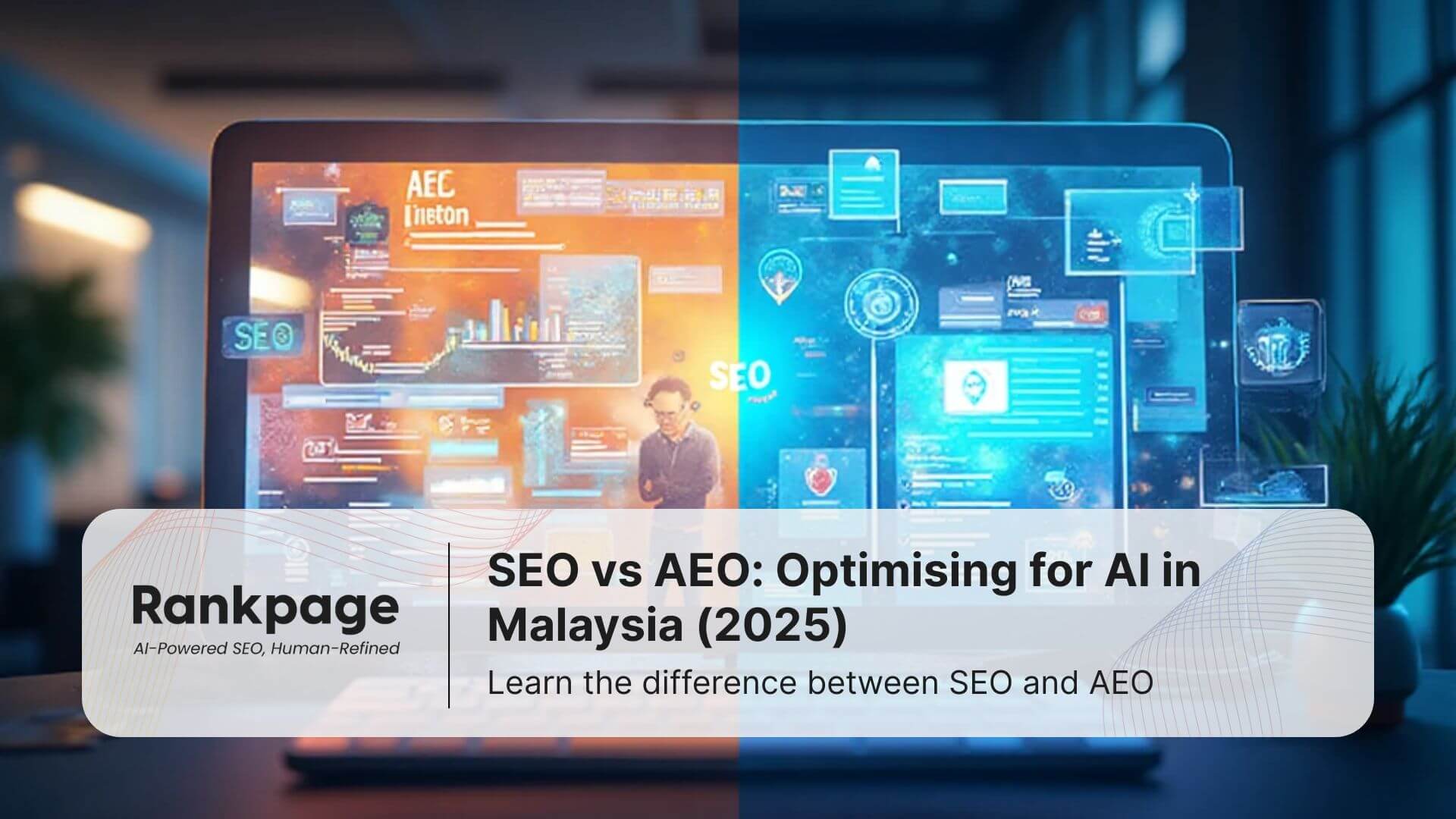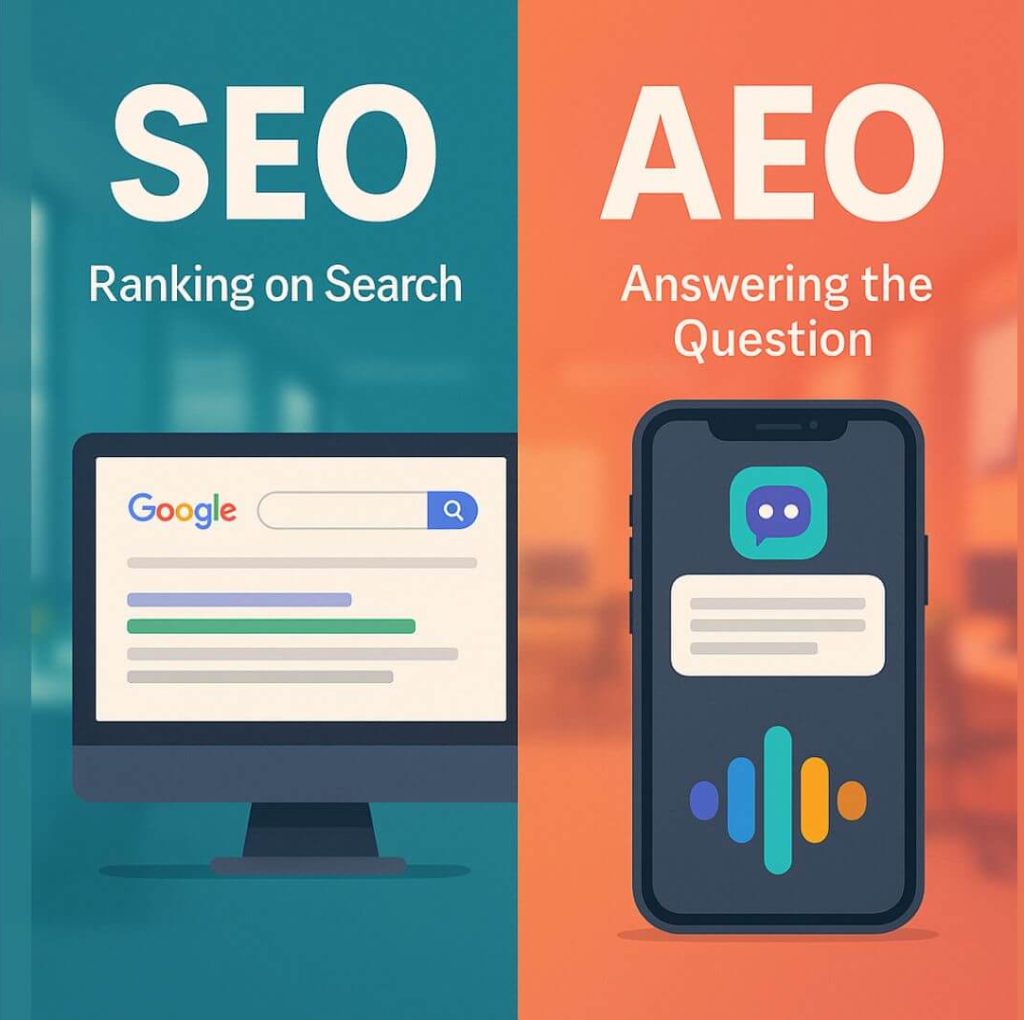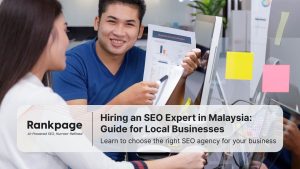Key Takeaways
- AEO (Answer Engine Optimisation) means designing content so AI‑powered systems can use it to directly answer user queries; SEO remains about ranking in search results.
- Malaysian search behaviour is shifting: voice search, AI chatbots, and zero‑click results are rising; businesses risk losing visibility if relying only on “traditional” SEO.
- To succeed with AEO in Malaysia, focus on structured data, concise Q&A content, conversational long‑tail queries, local relevance, and trust (E-E-A-T).
- SEO and AEO are complementary: good SEO provides a foundation; AEO builds on it to capture featured snippets, knowledge panels, AI summaries and voice responses.
- Measuring AEO success means tracking different metrics (mentions, citations, zero‑click impressions, featured snippets), not only rankings and traffic.
In 2025, optimizing for Google rankings isn’t enough. As AI‑powered tools like Google’s AI Overviews, ChatGPT, voice assistants, and zero‑click search get more common, Malaysian businesses face a new reality: users increasingly expect answers, not just links. That’s where Answer Engine Optimisation (AEO) comes in.
In this article you’ll learn:
- What AEO is and how it differs from traditional SEO,
- Why it matters especially for businesses in Malaysia,
- Concrete strategies to optimise for both SEO & AEO together,
- and How to measure success in this evolving landscape.
Table of Contents
What is Traditional SEO vs AEO?
In short: SEO remains essential as the baseline for being found via search, but AEO is rising as the next layer of optimisation so businesses can be “the answer” when users ask AI/voice/assistants.
Why AEO Is Especially Important for Malaysia Business in 2025
Here are local / regional factors that make AEO especially relevant for Malaysian businesses:
1. Growing use of mobile & AI tools
Malaysia’s high mobile smartphone usage among internet users is effectively universal and AI tool usage is mainstream. Structure content for quick, conversational answers and local intent (English/Bahasa/codeswitch where appropriate).
2. AI tools and generative search being adopted
Malaysian content creators and brands are already talking about GEO / AEO / generative‑engine optimization. The landscape is shifting.
3. Zero‑click search trends
Many queries now are answered right in search results via snippets, knowledge panels, maps, etc. This reduces click‑throughs to websites. If your content isn’t optimized to be that answer, you may lose out.
4. Local relevance matters
Users often ask location‑based questions (“near me”, “in Kuala Lumpur”, “which café in Penang”). Including local context, using Bahasa Malaysia where relevant, addressing regional issues, helps AEO effectiveness.
5. Competitive advantage
Many small/mid businesses may not yet be optimizing for AEO; early adopters can get visibility in AI‑driven features (snippets, assistant responses) and stand out.
How to Optimise for SEO + AEO: Tactics & Best Practices
Here are practical strategies Malaysian businesses can implement now to cover both SEO and AEO:
Common Mistakes & What to Avoid
- Writing long, full articles without summarising key answers at top: AI engines often extract only snippets or concise bits.
- Over‑stuffing keywords: conversational queries demand natural language; forced keywords can reduce clarity.
- Not using schema or structured data: without this, AI/voice systems may struggle to extract your content as an answer.
- Ignoring local or regional context: generic content may rank, but less chance to be the chosen answer for Malaysian‐centric queries.
- Not validating information / not maintaining accuracy: incorrect or outdated content can harm credibility, trust, and remove the chance of being cited as an authority.
What Results to Expect: Metrics & Timeline
- Short term (1‑3 months): improved visibility in featured snippets or answer boxes for selected questions; more voice queries returning your content; noticed mentions in AI overviews.
- Medium term (3‑6 months): increased zero‑click traffic or impressions; steady growth in conversational long‑tail search traffic; better engagement from content structured for direct answers.
- Long term (6‑12 months+): improved brand authority; possibly more indirect referrals from being cited repeatedly by AI tools; reduced dependency purely on ranking for high‑volume keywords.
Read more: How Long Does SEO Take to Show Results? The Answer Will Surprise You
Metrics to monitor:
- Number of featured snippets / knowledge panels your site appears in
- Zero‑click search impressions (if available via tools like GSC or others)
- Voice search visibility / queries
- Traffic from long‑tail and question‑based queries
- Mentions / citations in AI‑generated summaries or answer engines
- Local behaviour: map clicks, location queries
Case Examples & Localised Usage
- If you’re a café in KL, writing a page or blog post “What are the best cafés near Bangsar for coffee + wifi” in both English and Malay, with concise answer at top, map embed, opening hours will likely to get featured in voice search or AI Overviews.
- For e‑commerce: “What is the best rice cooker under RM200 in Malaysia?”, compare models, provide concise answers, specs, customer favourite; use FAQ structure; maybe include video/image; local shipping info.
SEO vs AEO: Balancing Both
SEO is still relevant, and AEO doesn’t replace it, it is an enlargement to it. For businesses in Malaysia, the most effective approach is to combine both strategies.
- Retain good keyword & link strategy to ensure basic discoverability.
- Layer in AEO‑friendly content: Q&A, featured snippet focus, concise answer boxes.
- Technical infrastructure (fast loading, mobile readiness, clean data) supports both.
- Local / language relevance to amplify chances of being chosen for direct answer.
Conclusion: Why Malaysian Businesses Can’t Afford to Ignore AEO
In 2025, the search environment is already shifting. Users increasingly expect immediate answers via voice, via AI assistants, via summarized results. Businesses that continue to depend solely on traditional SEO are risky on being invisible to the public.
By adopting AEO best practices, a structured content, clear answers, schema markup, local relevance, and conversational tone are important for you to stay competitive.
Need help implementing AEO in your digital strategy? Rankpage’s AEO Service is built to help Malaysian businesses optimise for AI-driven search results.
Disclaimer: This article is for information only not marketing, legal, financial, or technical advice. Search/AI features change and may not be available in all regions or languages (including Malaysia); no guarantees of rankings, inclusion, or results. Examples aren’t endorsements; trademarks belong to their owners.
Frequently Asked Questions About SEO vs AEO
What exactly is an “answer engine”?
It’s a system or tool (like ChatGPT, Google’s AI Overviews, voice assistants) that aims to provide a direct, concise answer instead of a list of links.
Does AEO replace SEO?
No. Think of AEO as a complement. SEO provides the foundational visibility; AEO ensures visibility at the point where users expect direct answers.
Do I need special tools to optimize for AEO?
Not strictly special ones, but tools that help you find long‑tail / conversational queries, monitor featured snippets, track voice search, and check structured data are very helpful.
Is content in Malay language useful for AEO in Malaysia?
Yes. Reacting to local language usage, question phrasing, and local dialects improves relevance. Mix of English / Malay / code‑switching may be appropriate depending on your audience.
How do I know if AI search is affecting my traffic?
Look for changes in search console / analytics: more impressions but fewer clicks (zero‑click behaviour), drop‑off in traffic from certain keyword types, but perhaps an increase in branded searches or direct queries.
When should I start optimising for AEO?
Now. Given how fast AI features are being rolled out (in Malaysia and globally), early adoption gives you an edge and builds content that will be durable as search evolves.







